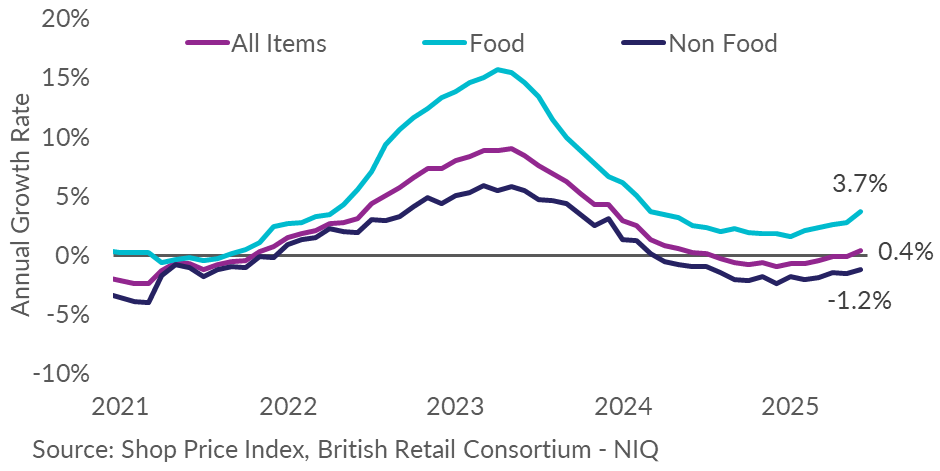Period Covered: 01 – 07
June 2025
- Shop price inflation increased to 0.4% year on year in June,
against a decline of -0.1% in May. This is above the 3-month
average of 0.1%.
- Non-Food inflation increased to -1.2% year on year in June,
against a decline of -1.5% in May. This is above the 3-month
average of -1.4%.
- Food inflation increased to 3.7% year on year in June,
against growth of 2.8% in May. This is above the 3-month average
of 3.1%.
- Fresh Food inflation increased to 3.2% year on year in June,
against growth of 2.4% in May. This is above the 3-month average
of 2.5%.
- Ambient Food inflation increased to 4.3% year on year in
June, against growth of 3.3% in May. This is above the 3-month
average of 3.8%.
|
|
OVERALL SPI
|
FOOD
|
NON-FOOD
|
|
% Change
|
On last year
|
On last month
|
On last year
|
On last month
|
On last year
|
On last month
|
|
Jun-25
|
0.4
|
0.3
|
3.7
|
0.7
|
-1.2
|
0.1
|
|
May-25
|
-0.1
|
0.2
|
2.8
|
0.4
|
-1.5
|
0.1
|
Note: Month-on-month % change refers to changes in the
level of prices.

Helen Dickinson, Chief Executive of the BRC,
said:
“Within three months of the costs imposed by last Autumn's Budget
kicking in, headline shop prices have returned to inflation for
the first time in close to a year. Food inflation showed little
sign of slowing down, particularly in fresh produce, where prices
of meat have been impacted by high wholesale prices and more
expensive labour costs. Meanwhile, fruit and vegetable prices
increased due to the hot, dry weather reducing harvest yields.
Non-food goods remained in deflation as retailers cut prices
across product categories, especially DIY and gardening so
customers could make the most of the sunshine.
“Retailers have warned of higher prices for consumers since last
year's Autumn Budget and the huge rises to Employer National
Insurance costs and the National Living Wage. We predicted a
significant rise in food inflation by the end of this year, and
this has been accelerated by geopolitical tensions and impacts of
climate change. To limit further rises, Government must find ways
to alleviate the cost pressures bearing down on retailers. The
upcoming business rates reform offers such an opportunity, and
the Government must ensure no shop pays more as a result of the
changes.”
Mike Watkins, Head of Retailer and Business Insight,
NielsenIQ, said:
“Price increases are being driven by
broader economic conditions and ongoing changes in the supply
chain. While the current spell of good weather is helping to
boost demand at many retailers, rising prices could become a
concern if consumer willingness to spend declines later in the
year. Which means we can expect retailers to reinforce their
value-for-money messages over the summer.”
